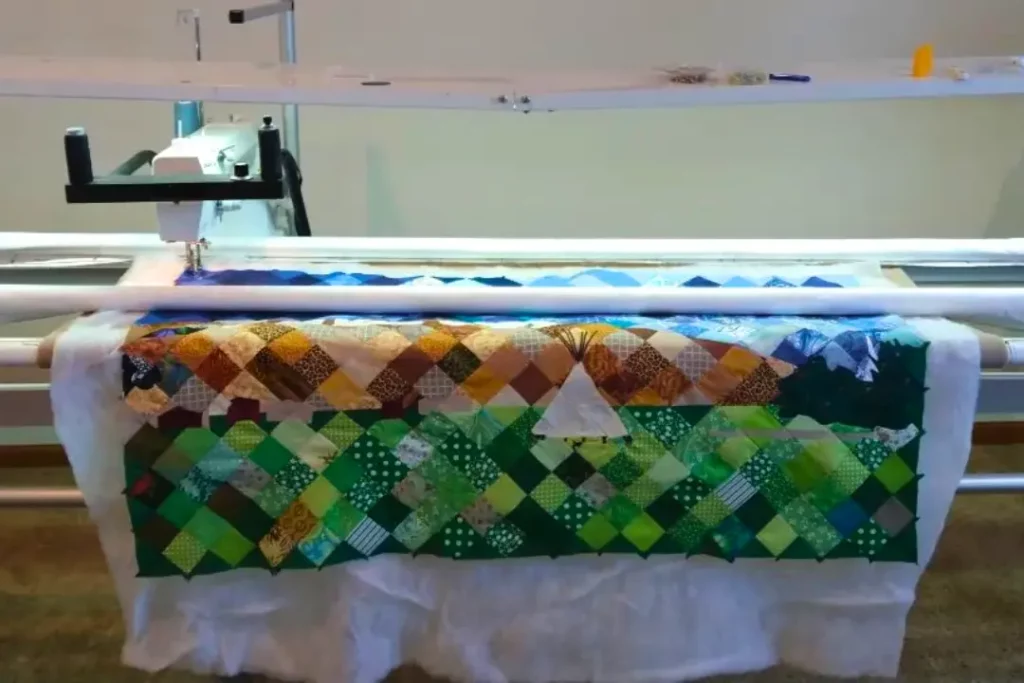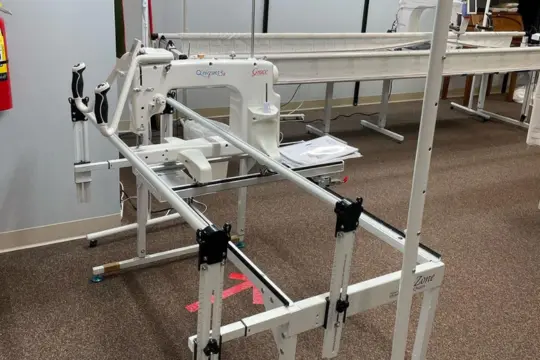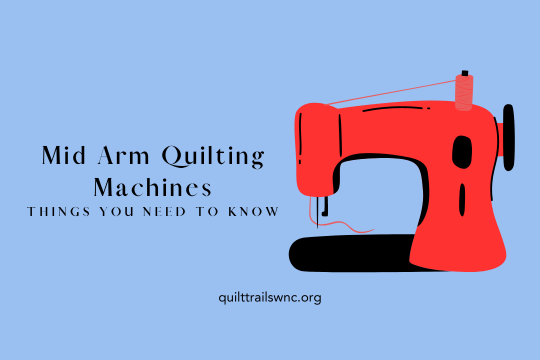Mid-arm quilting machines represent a significant leap forward in the world of quilting, providing an ideal balance between domestic sewing machines and their long-arm counterparts.
These machines offer an expanded workspace with a throat space typically ranging from 10 to 22 inches, allowing quilters to handle larger patterns or blocks than would be possible with a standard sewing machine.
Using a mid-arm quilting machine has several advantages, including:
- Greater Working Space: A mid-arm quilting machine offers more working space than a regular sewing machine, making it easier to manipulate larger quilts.
- Speed: These machines often have a faster sewing speed, which allows you to complete quilting projects more quickly.
- Quality: They typically provide a higher stitch quality, which is especially important in quilting, where the precision of the stitch can greatly impact the final appearance of the quilt.
Notable Features of Mid-Arm Quilting Machines

Of course, these mid-arm quilting machines are packed with some genuine features which attract so my quilters from all over the world.
1. Larger Throat Space
The primary feature that sets mid-arm quilting machines apart from domestic sewing machines is their larger throat space, which typically ranges from 12-17 inches. This additional space provides a more generous working area, allowing for the creation of larger quilt patterns and facilitating the movement of larger quilts, even king-sized ones, under the machine’s needle.
2. Enhanced Vertical Quilting Space
Another significant advantage of mid-arm quilting machines is their generous vertical quilting space. This feature makes it easier to slide even a king-sized quilt under the needle, which is particularly useful when quilting large projects.
3. Bobbins Variety
Mid-arm machines typically come with two bobbin sizes: an L-size, which is commonly found in standard home sewing machines, and an M-size which holds about three times as much thread. The larger bobbin requires less frequent changing, while the smaller one is ideal for detailed quilting work.
4. Positioning Flexibility
One of the unique features of mid-arm quilting machines is the flexibility in positioning. Unlike a regular sewing machine where the machine sits sideways, mid-arm machines can be situated so you’re facing the needle straight on, offering a more ergonomic experience and improved visibility.
A Guide For Beginners: How to Use Mid-Arm Quilting Machines
Here’s a beginner’s guide on how to use a mid-arm quilting machine. These machines can be an excellent choice for those who enjoy quilting and are looking to upgrade from a regular sewing machine.
Step 1: Understand Your Mid-Arm Quilting Machine
Firstly, get familiar with your machine. Different machines have different features and controls. Usually, they come with a manual – read it thoroughly to understand its functionality. Some key parts you should understand are:
- The Quilting Head: This is where the needle and bobbin are located. The quilting head moves on the frame to create the quilting stitches.
- The Quilting Frame: This holds the fabric layers in place. It usually has three bars: one each for the quilt top, batting, and backing.
- The Controls: These are usually on the handlebars or a screen on the quilting head. They control functions like stitch speed, stitch length, needle up/down, and more.
Step 2: Prepare Your Quilt
Prepare your quilt by ironing all your pieces and cutting them to the correct size. Stitch together your quilt top and make sure you have your backing and batting ready.
Step 3: Load the Quilt onto the Frame
Start by loading your backing fabric onto the backing bar, wrong side up. Roll it onto the bar and make sure it is smooth and tight. Next, load your batting onto the batting bar. Lastly, add your quilt top onto the top bar, right side up. Make sure all layers are smooth and aligned.
Step 4: Threading the Machine
Refer to your machine’s manual for specific threading instructions as this can vary among models. It’s important to thread correctly to avoid issues with tension or stitch quality.
Step 5: Check and Adjust the Tension
First, insert a bobbin with the same thread as on top. Next, sew a test on some scrap fabric. If the top thread shows on the bottom, the tension is too tight. If the bobbin thread shows on the top, the tension is too loose. Adjust accordingly.
Step 6: Start Quilting
Now that your quilt is loaded and your machine is set up, it’s time to start quilting. You can either use free-motion quilting or follow a pantograph design.
- Free-motion Quilting: In this method, you move the quilting head in any direction to create your own designs.
- Pantograph Quilting: In this method, you follow a pre-printed design with your machine. The design is placed at the back of the machine, and you follow it from there.
Step 7: Practice
As with any skill, practice makes perfect. Try out different designs, play with different tensions, and get used to how the machine moves. The more you quilt, the better you will become.
Step 8: Maintenance
Keep your machine clean and well-oiled according to your machine’s manual. Regular maintenance will ensure your machine lasts longer and performs well.
Choosing the Right Mid-Arm Quilting Machine

In order to choose the perfect mid-arm quilting machine for you, here you need to consider 3 things. Read below to know the important factors:
1. Powerful Motor and High Speed
When choosing a mid-arm quilting machine, consider machines like APQS George or the PFAFF Powerquilter 16.0, which boast powerful motors that can stitch up to 1,500 times a minute. These machines also come with additional features such as a color touchscreen, a needle up-down button, and additional feet to help you see more of the quilt.
2. Stitch Regulator
Many mid-arm quilting machines, such as the Baby Lock Tiara III and the Handi Quilter Sweet Sixteen, offer the option of adding a stitch regulator. This feature provides more speed control and accurate stitching, but it is not necessary if you prefer setting your own stitching rhythm.
3. High-Quality Models
The quality of the machine you choose significantly impacts your quilting experience. Models like the Grace Q’nique 15R have earned a reputation among the best mid-arm quilting machines due to their superior features and performance.
There is no doubt that mid-arm quilting machines offer a more spacious workspace, faster speed, and more control than standard sewing machines, making them a fantastic investment for avid quilters.
FAQs About Mid-Arm Quilting Machines
1. What is a Mid-Arm Quilting Machine?
A mid-arm quilting machine is a specialized machine designed for quilting. It offers a larger workspace compared to a domestic sewing machine, with throat space typically ranging from 10 to 22 inches. This allows for the handling of larger quilt patterns or blocks.
2. How is a Mid-Arm Quilting Machine Different From a Domestic Sewing Machine?
Mid-arm quilting machines differ from domestic sewing machines primarily in their larger throat space, which ranges from 12-17 inches. Additionally, most mid-arm machines do not have feed dogs, meaning they cannot perform typical sewing functions.
3. Can I Use a Mid-Arm Quilting Machine for Regular Sewing?
Most mid-arm quilting machines are designed specifically for quilting and do not feature feed dogs, thus they cannot perform typical sewing functions.
4. What are the Benefits of Using a Mid-Arm Quilting Machine?
Mid-arm quilting machines offer several benefits including a larger throat and vertical quilting space, allowing you to easily handle even king-sized quilts. They also come with two bobbins of different sizes and offer flexibility in positioning, with the machine capable of being situated so you’re facing the needle straight on.
5. What Should I Consider When Choosing a Mid-Arm Quilting Machine?
Key factors to consider when choosing a mid-arm quilting machine include the power of the motor and stitching speed, the option of adding a stitch regulator, and the quality of the model. High-quality models such as the Grace Q’nique 15R are often recommended.
Sources

Leave a Reply